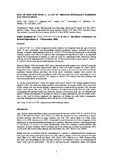| dc.contributor.author | Arimi, S.M | |
| dc.contributor.author | Koroti, E | |
| dc.contributor.author | Kang'ethe, E.K | |
| dc.contributor.author | Omore, A.O | |
| dc.contributor.author | McDermott, J.J | |
| dc.contributor.author | Macharia, J.K | |
| dc.contributor.author | Nduhiu, J.G | |
| dc.contributor.author | Githua, A.M | |
| dc.date.accessioned | 2013-06-30T08:28:34Z | |
| dc.date.available | 2013-06-30T08:28:34Z | |
| dc.date.issued | 2000 | |
| dc.identifier.citation | Arimi, S.M., Koroti, E., Kang'ethe, E.K. et al (2000). Risk of infection from E. coli O157: H7 through informally marketed raw milk in Kenya. Paper prepared for ORAL PRESENTATION at the 3rd All Africa Conference on Animal Agriculture. 6 – 9 November 2000. | en |
| dc.identifier.uri | http://hdl.handle.net/11295/42760 | |
| dc.description.abstract | E. coli 0157:H7 is a newly recognised bacterial zoonosis that originates from the gut of infected cattle. It causes potentially fatal haemorrhagic enteritis, haemolytic uraemic syndrome and kidney damage in humans. Epidemiological data on E. coli 0157:H7 infection and transmission in developing countries remain scarce but it is suspected that consumption of unpasteurised milk is an important vehicle for its transmission to humans, as milk can easily be contaminated with cattle faeces during milking. Given the high proportion of informal sales of unpasteurized milk in many tropical countries, E. coli 0157:H7 has been one of several zoonoses of concern.
Between January 1999 and January 2000, survey data and raw milk samples were collected seasonally from households consuming unpasteurised milk in rural and urban locations in central Kenya. Respondents were randomly selected within production system (extensive and intensive) and human population density (urban, peri-urban and rural) strata. Laboratory samples were assessed for bacteriological quality by total and coliform counts. Selective media were used sequentially to screen for faecal coliforms and E. coli 0157:H7. Suspect E. coli 0157:H7 colonies were also serotyped and tested for production of verocytotoxins.
E. coli was recovered from 91 out of 264 samples (34%) and E. coli 0157:H7 serotype identified in two samples (<1%). One of the two isolates produced verocytotoxins. As in many studies, the recovery rate of this serotype was low, but the finding is significant from a public health perspective. Our consumer studies have shown that over 95% of consumers of unpasteurised milk boil the milk before consumption and potential health risks from this zoonosis are therefore quite low. As informal milk markets without pasteurisation technology are likely to remain dominant for the foreseeable future, there is the need to further emphasise the importance of boiling raw milk before consumption, especially among pastoral communities where this practice is not common. | en |
| dc.language.iso | en | en |
| dc.title | Risk of infection from E. coli O157: H7 through informally marketed raw milk in Kenya | en |
| dc.type | Presentation | en |
| local.publisher | Department of Public Health, Pharmacology and Toxicology, University of Nairobi, | en |
| local.publisher | Kenya Agricultural Research Institute (KARI), Nairobi | en |
| local.publisher | International Livestock Research Institute (ILRI), Nairobi | en |

